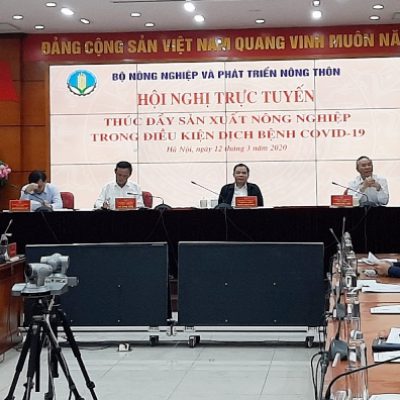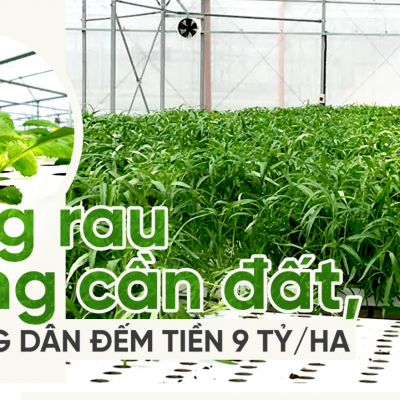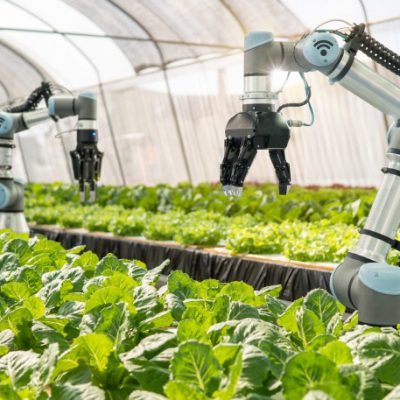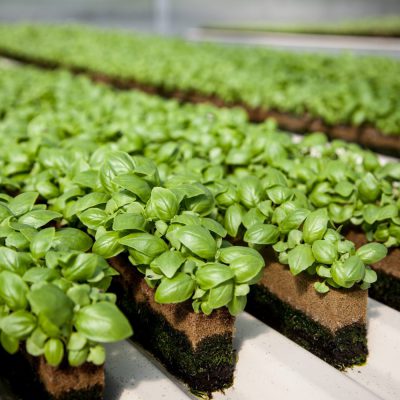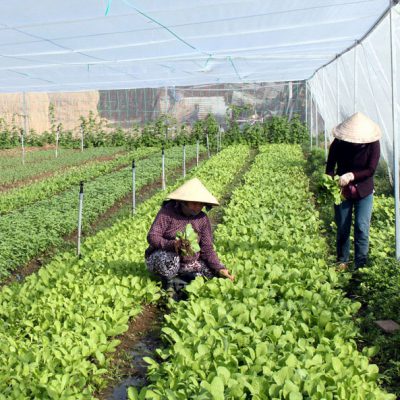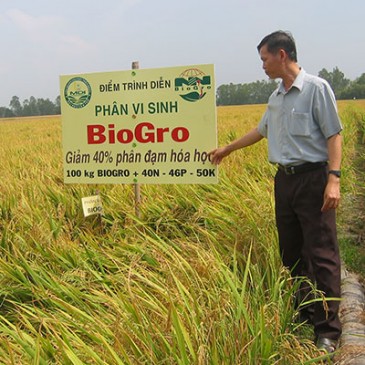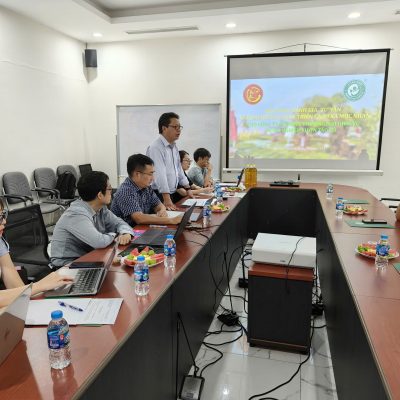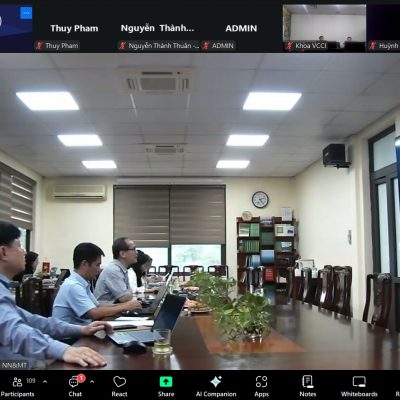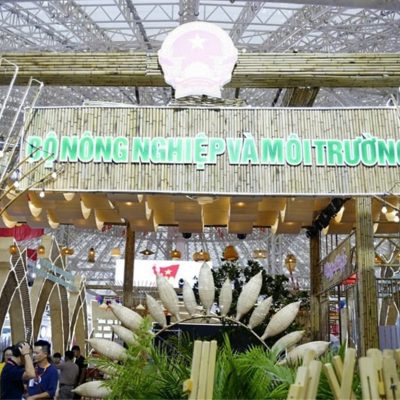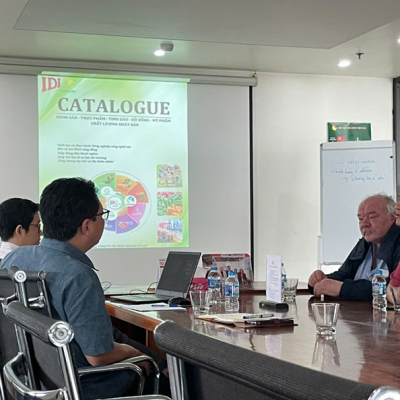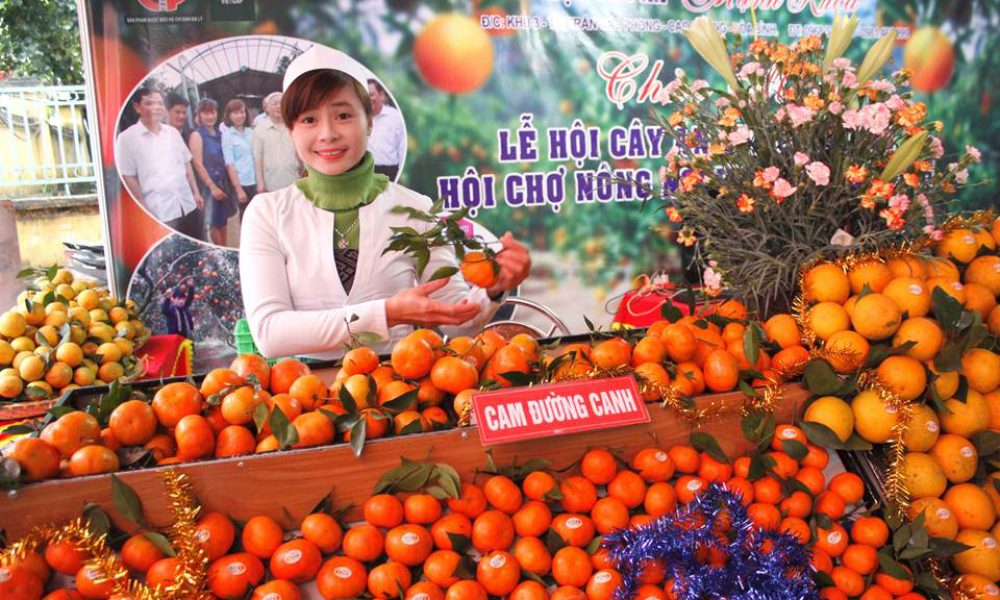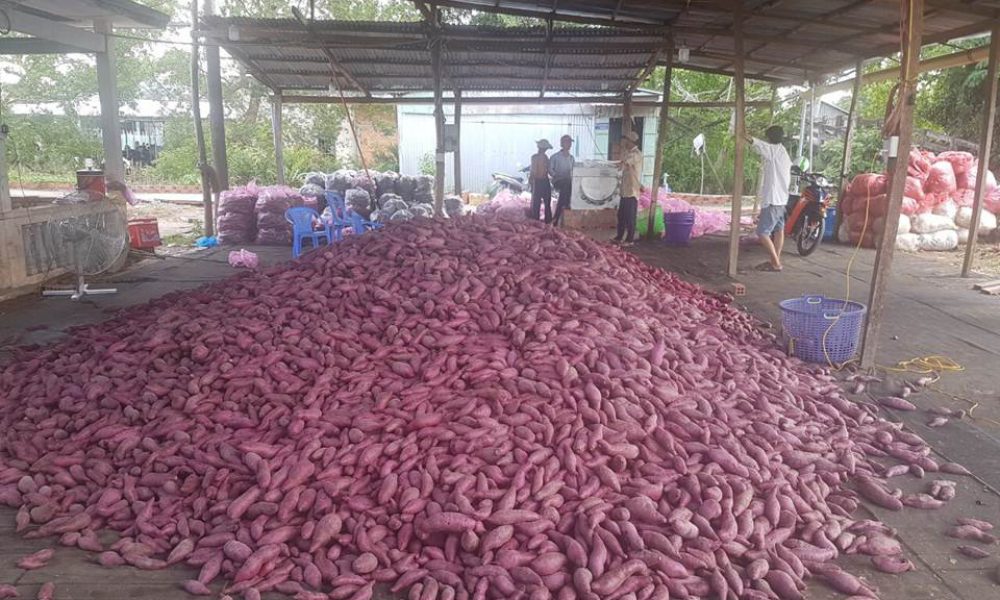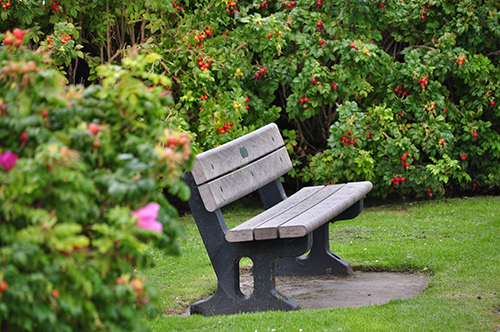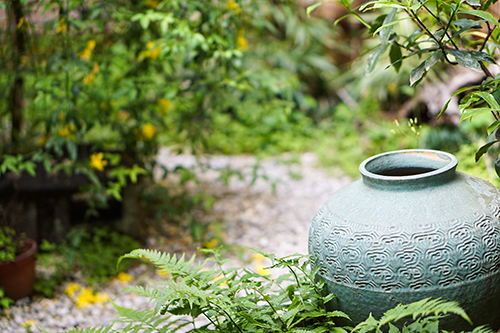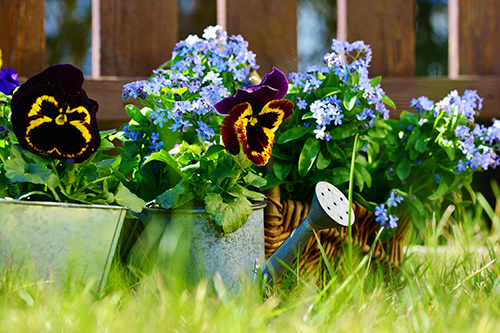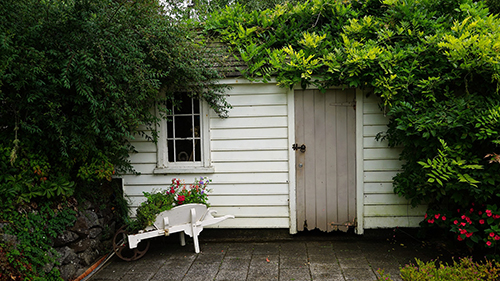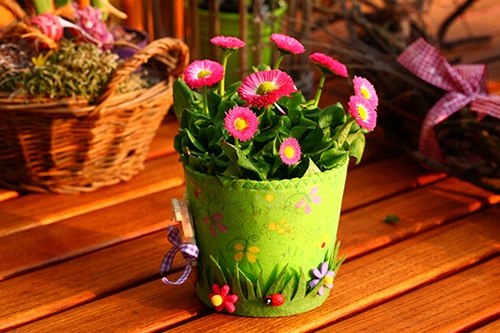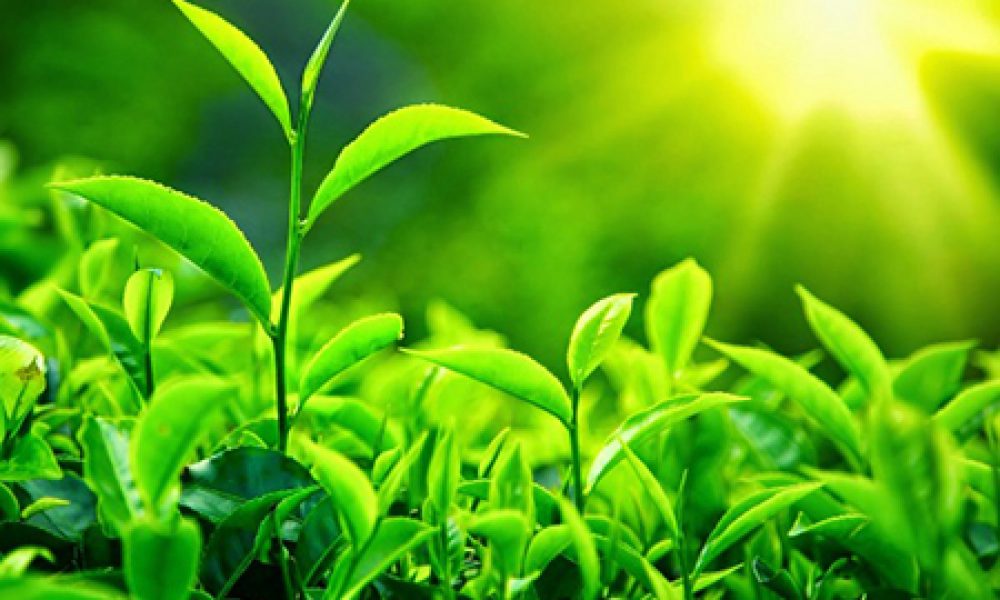
Online conference "Promoting agricultural production in the conditions of CIVI-19 epidemic"
Pm 12/3, Ministry of Agriculture and Rural Development (NN&PTNT) tổ chức Hội nghị trực tuyến “Thúc đẩy sản xuất nông nghiệp trong điều kiện dịch bệnh Covid-19”. Hội nghị tổ chức trong bối cảnh dịch bệnh đang có diễn biến phức tạp ở trên thế giới và cả Việt Nam, đặt ra những thách thức lớn cho ngành nông nghiệp. Bộ trưởng Nguyễn Xuân Cường tham dự và chủ trì hội nghị.
Theo báo cáo của Bộ NN&PTNT, 2 the first month of the year 2020, kim ngạch xuất khẩu của ngành đạt 5,34 billion USD, reduction 2,8% over the same period in the year 2019. Kim ngạch nhập khẩu ước khoảng 4,3 billion USD, reduction 6,7% over the same period in the year 2019. Thặng dư thương mại 2 tháng đạt 1,02 billion USD, increase 18,4% compared to the same period last year.
Dự báo thời gian tới, kinh tế toàn cầu tiếp tục xu hướng tăng trưởng chậm. Các nền kinh tế chủ chốt đối mặt với nhiều khó khăn. Sự bùng phát của dịch Covid-19 diễn biến nghiêm trọng, complex, chưa dự báo được thời điểm kết thúc gây ảnh hưởng tiêu cực tới tăng trưởng kinh tế thế giới. Domestic, ngành nông nghiệp đối mặt với nhiều khó khăn, thách thức như: biến đổi khí hậu xuất hiện ngay từ đầu năm gây ra tình hình hạn hán, xâm nhập mặn tại đồng bằng sông Cửu Long ảnh hưởng tới ngành trồng trọt và nuôi trồng thủy sản; dịch tả lợn châu Phi tuy có giảm mạnh nhưng chưa được khống chế hoàn toàn nên vẫn gây khó khăn cho công tác tái đàn.
Dịch Covid-19 đã thành đại dịch, hết sức nguy hiểm, gây ra 2 vấn đề bao trùm là đe dọa sức khỏe, tính mạng người dân trên toàn cầu và làm rối loạn nền kinh tế thế giới. Dịch này tác động đến hầu hết các quốc gia. Nhiệm vụ đặt ra là đảm bảo hạn chế thấp nhất thách thức nêu trên đồng thời đảm bảo tăng trưởng.
Trước các tình hình đó, Ministry of Agriculture&PTNT đưa ra dự báo về mức tăng trưởng ngành nông nghiệp của Việt Nam trong thời gian tới với các con số cụ thể.
Về diện tích lúa, đơn vị ước tính đạt 7,3 triệu ha/năm, năng suất bình quân ước đạt 59,3 tạ/ha và sản lượng ước đạt 43,4 million tons, giảm khoảng 70.000 tấn so với năm 2019.
Về rau màu, The output is expected to reach 18,2 triệu tấn trên 980.000 he has. Với lượng tiêu thụ trong nước khoảng 14 triệu tấn thì mặt hàng này vẫn dư khoảng 4,2 triệu tấn để xuất khẩu. Besides, sản lượng trái cây còn có thể tăng 0,8 triệu tấn so với năm 2019.
Để đạt được các mục tiêu thúc đẩy này, Bộ Nông nghiệp đặt ra một số giải pháp trước mắt như chỉ đạo cơ quan chuyên môn, địa phương có những điều chỉnh phù hợp về cơ cấu mùa vụ lúa. Cơ quan chuyên môn cũng cần rà soát xây dựng, phát triển các vùng sản xuất đối với sản phẩm xuất khẩu chủ lực, ứng dụng công nghệ cao trong bảo quản, process.
Bộ yêu cầu các đơn vị trực thuộc tiếp tục triển khai các đoàn công tác xúc tiến, phát triển thị trường tại các địa phương trọng điểm của Trung Quốc, ngay sau khi phía Trung Quốc kiểm soát dịch Covid-19 và công bố mở cửa lại bình thường.
“Các đơn vị cần chuẩn bị sẵn cả phương án, kịch bản nhu cầu nông sản, thủy sản của nhiều địa phương có dịch Covid-19 tăng cao sau khi hết dịch”, Bộ trưởng Nông nghiệp đề nghị.
Especially, Bộ yêu cầu các đơn vị, địa phương tổ chức lại hệ thống phân phối gắn kết với người sản xuất. Phương án này bao gồm chuẩn bị kịch bản trong bối cảnh nhiều địa phương công bố dịch Covid-19 sẽ dẫn đến nhu cầu cao và số lượng lương thực thực phẩm, do tâm lý và nhu cầu tích trữ phòng dịch của người dân.
Phát biểu tại Hội nghị, ngoài đề cập thách thức từ dịch COVID-19 đã mang tính chất toàn cầu, Bộ trưởng Bộ NN&PTNT Nguyễn Xuân Cường phân tích cụ thể 3 thách thức lớn bao trùm ngành Nông nghiệp của Việt Nam trong thời gian tới. Đó là tính phức tạp, khó lường của khí hậu, thời tiết; hạn hán và xâm nhập mặn; dịch bệnh trên gia súc gia cầm diễn biến phức tạp.
Bộ trưởng cũng khẳng định rằng, chưa bao giờ ngành chăn nuôi có quy mô lớn như vậy, tổng đàn gia súc gia cầm đạt mức cao và kỷ lục nhất từ trước đến nay. Year 2020 this, ngành chăn nuôi chính là cứu cánh của cả ngành Nông nghiệp.
Liên quan đến ngành chăn nuôi, from the beginning of the year to the present, cả nước xuất hiện 44 ổ dịch cúm gia cầm (39 ổ dịch do virus cúm A/H5N6 và 5 ổ dịch do virus cúm A/H5N1) VnSAT project helps farmers change farming methods 14 the provincial, thành phố gồm: Hanoi, Hai Phong, Quang Ninh, Peace, Bac Ninh, Hà Nam, Ninh Bình, peaceful, Thanh Hoa, Nghe An, Quang Ngai, Khánh Hòa, Bình Dương và Trà Vinh. Tổng số gia cầm chết, buộc tiêu hủy là 137.180 with.
Công tác thú y hiện nay còn nhiều khó khăn. Hệ thống thú y cơ sở, nhất là thú y cấp thôn, commune, huyện ở nhiều nơi không còn hoặc đã sáp nhập thành Trung tâm Dịch vụ nông nghiệp, nhưng không nắm được tình hình, không báo cáo đến cơ quan chuyên môn cấp trên để được hướng dẫn, xử lý kịp thời.
Việc tổ chức thực hiện các biện pháp phòng, chống dịch bệnh tại cơ sở chưa tốt; việc xử lý các ổ dịch chưa được thực hiện triệt để, chưa bảo đảm đúng yêu cầu kỹ thuật; khoanh vùng, cảnh báo và quản lý ổ dịch còn khó khăn. Thiếu sự kiểm tra, đôn đốc, giám sát thực hiện, đặc biệt tại tuyến cơ sở; chính quyền và cơ quan chuyên môn tại một số địa phương (Quang Ngai, Quảng Nam, Thanh Hoa) chưa chỉ đạo quyết liệt công tác phòng, chống dịch…
Giải pháp được ngành Nông nghiệp đưa ra trong thời điểm này là tiếp tục tổ chức nghiên cứu các giải pháp tổng thể phòng, chống dịch bệnh; hợp tác và tranh thủ sự hỗ trợ của quốc tế và các nước để phòng, chống bệnh dịch tả heo châu Phi và nghiên cứu, sản xuất vắc-xin phòng bệnh này. Hướng dẫn, giám sát việc nuôi tái đàn heo theo nguyên tắc áp dụng nghiêm ngặt các biện pháp cách ly, toilet, sát trùng và các biện pháp an toàn sinh học, dưới sự giám sát của chính quyền cơ sở và các cơ quan chuyên môn. Support, tạo điều kiện thuận lợi cho các doanh nghiệp chăn nuôi lớn, các trang trại, gia trại có điều kiện đảm bảo chăn nuôi an toàn sinh học được tái đàn, để cung cấp các sản phẩm thịt heo cho thị trường và bình ổn giá.
V.A tổng hợp
Do hi-tech farming, farmers collect 9 billion VND/ha
Bringing technology to the field
The image of "buffalo goes first" is gradually fading away, the plow follows” with tens of millions of small fields, Lately year, In the countryside of our country, more "high-tech fields" have appeared..
Over there, farmers apply technological achievements, change the method of production, working in the fields by remote control… to optimize the production process, improve the quality of agricultural products, environmental Protection, improve the lives and enrich the farmers.
At a conference on high-tech agriculture (Agriculture 4.0) was just held in Lam Dong, Mr. Da Cat Vinh – Chairman of Lam Dong Provincial Farmers' Association – comment, the application of information technology, Automation in the agricultural sector has contributed to improving production efficiency, increase product value and increase labor productivity…
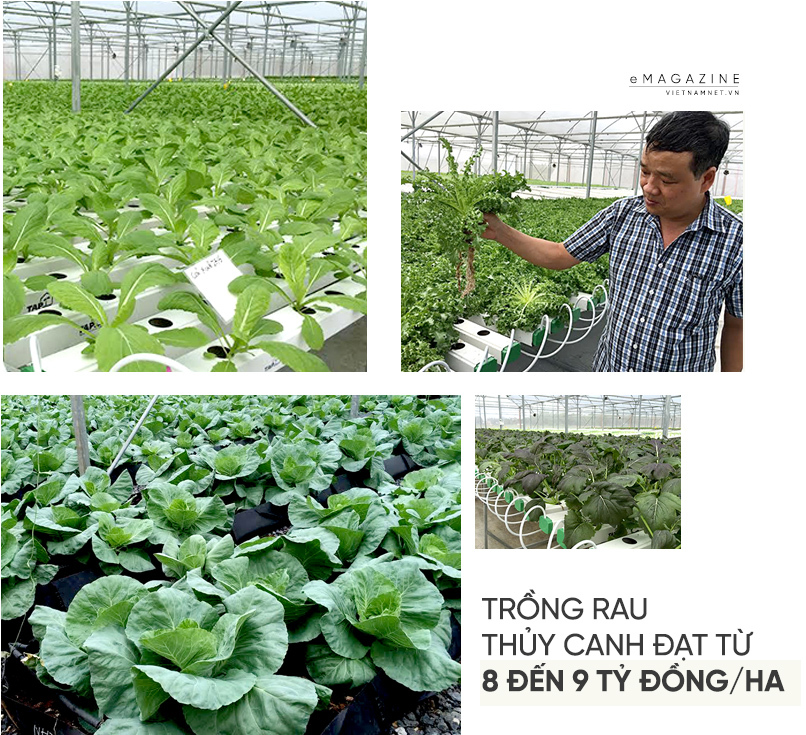
Currently, there are many high-investment agricultural models applying information technology, Farmers boldly invest in production such as a greenhouse system with an automatic adjustment system, sensor device, camera to monitor plant growth, IoT technology… bringing the area of high-tech application of Lam Dong to increase rapidly, not only concentrated in the districts, become the focal point where many types of technology have been widely applied to create the brand name of the province's agricultural products. Information technology combined with electronics, telecommunication, Automation has solved many weather forecasting problems; Forecast of plant diseases, pet; forecast market consumption of agricultural products… Lately year, Lam Dong farmers have been able to access and apply information technology to agricultural production.
Mr. Vinh said, Lam Dong has over 56.000 ha area of high-tech agricultural production, average production value is about 400 million / ha; more advanced vegetable production model 500 million dong / ha / year, Especially hydroponic vegetables reach from 8 come 9 billions dong; flower 1,2 billions dong, High quality tea 250 million dong and coffee reached 240 million dong / ha / year…
Share success stories from hi-tech agriculture, Mr. Nguyen Cong Thua – Chairman of Anh Dao Cooperative (TP. Da Lat, Lam Dong) once said, The cooperative is applying greenhouse technology, greenhouses and applying automation equipment to irrigation.
Currently, the cooperative is growing VietGAP vegetables and fruits to supply to supermarket systems across the country and export, average consumption 50.000 domestic tons and 4.000 export tons. More revenue 10 million USD / year, Mr. Thua revealed.

Although bringing high economic efficiency, song, Mr. Vinh also admitted, area of land for high-tech application production, Information technology is still limited when it only accounts for about 20% arable land area, not commensurate with the potential and strengths of the province's agriculture.
The percentage of farmers applying information technology in production is still too small compared to the number of agricultural production households; models, Farms are successful in production thanks to the application of scientific and technological achievements, most of them are still quite young, most have received certain specialized training, sensitive and easy access to the achievements of information technology to apply in agricultural production.
The majority of farmers in Lam Dong still produce by traditional methods, fragmented land area, is still passive and has not mastered technology and is not confident yet, boldly apply achievements, efficiency of technology in production, breed.
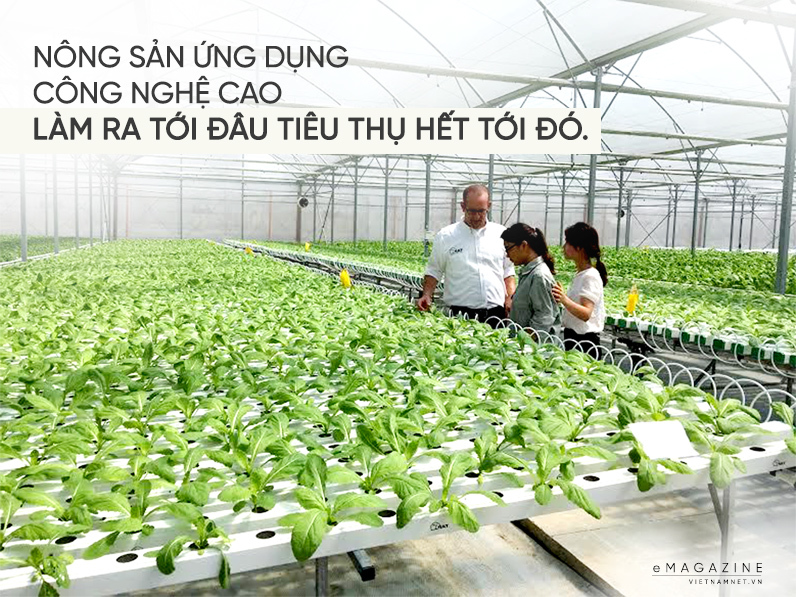
To solve the problem for farmers who are willing to work in agriculture 4.0, According to Mr. Vinh, It is necessary to have sufficient capital and specific mechanisms and policies, More incentives to invest, encourage farmers to develop high-tech agriculture, This is the key step.
Mr. Chu Phu My – Director of Hanoi Department of Agriculture and Rural Development, recently thought that, Although the cost is higher than that of mass-produced agricultural products, about 20-30%, but high-tech agricultural products are favored by the market, do as much as you can and consume it all.
Hanoi is available 133 high-tech agricultural model. Remarkable, 100% this model in farming, livestock production is up to export standards. But the quantity is still small, has not yet met the demand for local consumption, Mr. America admitted.
Next time, The city's agricultural industry will focus on building a brand, promotion, promote the development of more agricultural models 4.0, at the same time promoting towards export of these products. Inside, will focus on livestock and fruit trees.
Firstly, with the motto "many small areas add up to a large area", The Department of Agriculture and Rural Development will mobilize people in a cooperative to jointly produce strong products with application of science and technology.. At the same time, encourage businesses to associate with farmers to advise on the process, techniques to create high value product chains, Mr. My shared.
Source: Vietnamnet Newspaper
How 5G technology will revolutionize the agricultural industry?
Super high-speed 5G mobile network promises to revolutionize agriculture, which has long been slow to accept new innovations.
Tech experts say, wireless sensors connected over a 5G network can monitor field conditions and detect when crops need watering, pesticides or fertilizers hoặc. It can also help track livestock and control agricultural drones and self-driving tractors.
“5G has the potential to have a transformative impact on the global economy through a number of different verticals, and agriculture is certainly one of the most prominent to consider.”, Leo Gergs, analyst of ABI Research said.
Theoretically, The end result for agriculture will be improved crop yields and higher quality products. But actually turning a promise into a reality is unlikely to happen quickly or easily.
While major mobile carriers like Verizon , AT&T and T-Mobile of the US are racing to deploy 5G, but so far they have only focused on urban areas because there are many potential customers.. It will be many years before their 5G network is widely available in rural areas, which means most farmers will have to wait.
Comments on the impact of 5G on the agricultural industry, Bill Morelli, an analyst at IHS Markit says: “5G will probably not have a discernible impact on farming in the future.” 3 come 5 Another year".
The current, many farmers have installed sensors in their fields that are connected by 4G networks with speeds up to 100 Mbps. However, compared to 5G speeds expected to reach 10 Gbps is to be expected. The difference in speed allows for faster connections between devices, while 5G networks also allow more devices to connect to a single mobile base station..
While, Simon Forrest, Analyst at Futuresource said cho: “Sensors have been used in agricultural farming to measure and report environmental conditions such as rainfall, the amount of water, water content, soil nutrients and ground temperature”.
Upgrading to 5G can increase the impact of the technology by improving connection speeds and allowing devices to communicate more efficiently. For example, it will allow farmers to install more sensors to track more data points and help them run their operations more efficiently.
According to statistics from ABI Research, the US currently has 2,1 million agricultural workers with each average farm employing about 45 labor. These numbers will decrease over time as farmers apply more technologies to production.
Leo Gergs commented: “5G will change the nature of work in farming and agriculture. To the year 2035, the number of agricultural jobs is expected to fall to 1,78 million VND at the same time the farm will use on average only 27 labor".
However, in Bill Morelli's view, it is not certain that more technology nhiều, including 5G will really affect the overall amount of work on the farm. He admits that different roles will require higher demands such as data analytics and farm management capabilities., but that doesn't necessarily reduce the number of workers.
Bill Morelli commented: "General, Smart agriculture allows farmers to access more information and get higher efficiency, rather than eliminating jobs. It is likely that there will be a transformation as with any other technological transformation.”.
The United Nations Food and Agriculture Organization estimates that the planet will need more 70% food in the year 2050 compare with year 2009 due to increase in global population. Advances in agriculture will be a major contributor.
“Technology must be applied to the agricultural sector”. Connectivity is essential and therefore the application of 5G in agriculture is inevitable.”, Simon Forrest says.
(Source: Vietnamnet Newspaper. According to Fortune)
AGRICULTURE IN THE FUTURE: NO NEED TO LAND AND SUN
AeroFarms, startup based in New Jersey, has found a more sustainable and radical solution to produce food for the world in the future. This technology is possible saving 95% country, 40% fertilizer and no use of pesticides.
According to the US Geological Survey, cultivated to use 70% The amount of fresh water is used for agriculture and only about a quarter of it can be recycled after use. Cultivation also requires large amounts of land and adequate amount of sunlight.
AeroFarms thinks they have a better solution. The company's farming method uses very little water and requires no soil or sunlight. The whole process takes place indoors, usually in an old warehouse, means that in theory, Any place can become a place of cultivation.
The New Jersey-based startup is the brainchild of Ed Harwood, Professor at Cornell College of Agriculture. Year 2003, Harwood invented a system to grow plants on cloth material he created.
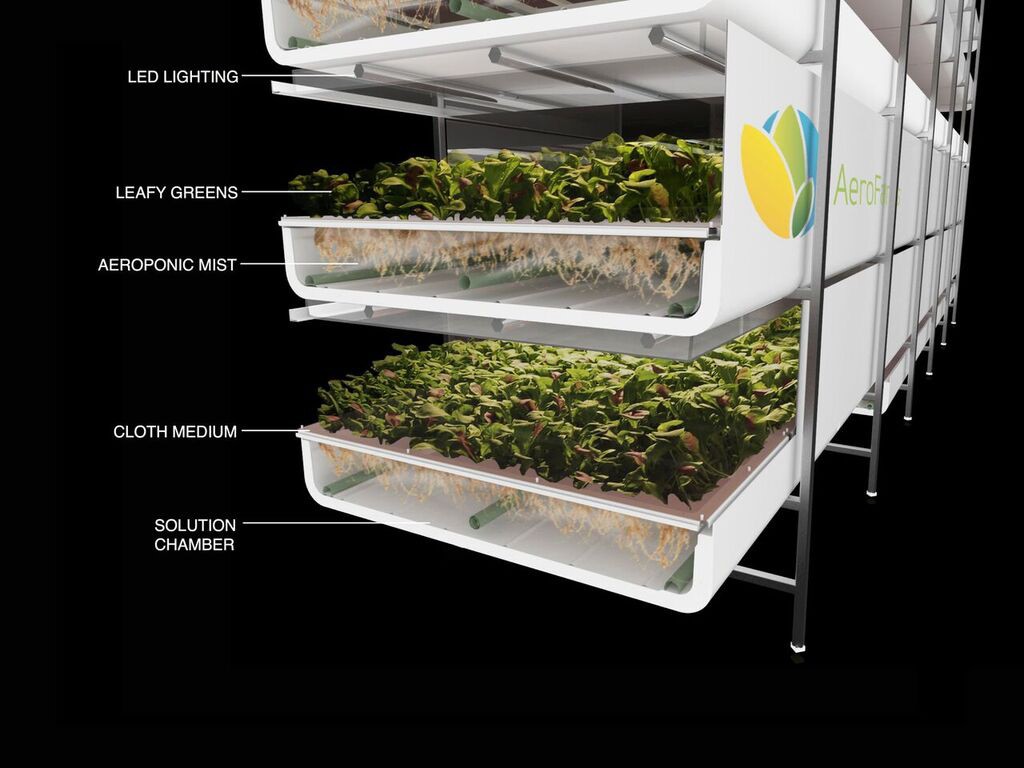
Under the cloth was not soil, instead, The roots are misted with rich nutrients. Harwood patented his invention and founded Aero Farm Systems. The reason the company got its name because "aeroponics" is a method of growing trees that does not use soil or water. Aero Farm Systems sells this specialty growing system, but it was just a side project of Harwood and did not generate much revenue.
The turning point came in the year 2011, when David Rosenberg, founder of Hycittle waterproof concrete company, and Marc Oshima, a veteran marketer in the food and restaurant industries, noted the inefficiency of traditional farming and viewed this as an investment opportunity.
The duo began to explore potential farming methods and in the process turned their attention to Aero Farm Systems. They liked Harwood's brainchild so much that they offered to pump money into the project. Exchange, they want to be co-founders. At the same time, They also suggest some changes in the business model: Rosenberg and Oshima see a greater opportunity to optimize farming and sell the crops themselves.
Get Harwood's consensus, Aero Farm Systems has become AeroFarms. Harwood, Rosenberg and Oshima act as co-founders. They buy old facilities in New Jersey - a steel mill, a club, a paintball gun center - and turn them into indoor farms.

Every farm of these AeroFarms grows carrots, cucumber, potatoes and main product – premium sprouts – on stacked trays. These products are then sold to East Coast grocery stores including Whole Foods, ShopRite and Fresh Direct as well as the dining rooms of businesses like Goldman Sachs and The New York Times.
When cultivation can take place locally all year round, AeroFarms hopes that they can offer newer fresh products at a lower price, Because shipping costs are kept to a minimum.
In addition, AeroFarms collects hundreds of thousands of data points at each of its facilities. This allows them to easily change the LED lighting system to control the taste, structure, plant color and nutrition. The data also allows the startup to adjust variables like temperature and humidity to optimize crop yields.
Theo AeroFarms, This process is very effective: This farming method has a fold yield 130 times per ft2 compared to traditional ranch, from a crop yield perspective. An Aero Farm is more economical 95% water and 40% fertilizer compared with traditional farming, at the same time do not use pesticides. Plants often lose words 30 come 45 days to grow. While, High quality leafy green vegetables that make up the bulk of the company's production need at least 12 day.
AeroFarms does 120 Staff, mobilize more 100 million dollars, from businesses including Goldman Sachs and GSR Ventures.
AeroFarms argues that their farming methods are especially useful in regions with a climate that is not farming friendly., or where water or soil is scarce. This startup is currently owned 9 farm, including locations in Saudi Arabia and China. AeroFarms has plans to expand up 25 farm within 5 next year.
Organic agriculture production in Hanoi: Clearly defined strategy, create the right direction
Hanoi city has been implementing many organic agricultural models, Initial steps bring remarkable effects. This is a suitable direction for the development trend of modern agriculture. However, to replicate this model, besides mechanisms and policies to attract producers, enterprise, There is a need for a market strategy for organic agricultural products to have a foothold.

Manufacturing, Consume evenly… entanglement
Hanoi city is one of the regions that are strongly developing organic agriculture, with a total area of about 80-100ha, mainly concentrated in districts: Soc Son, Long Bien, Thach That. However, to develop organic agriculture in the current context, Hanoi has to resolve a number of problems early, from production to product consumption.
Ms. Hoang Thi Hau, Chairman of Thanh Xuan Commune Farmers' Association (Soc Son district) said, Organic vegetable products of Thanh Xuan commune are highly appreciated by consumers for their quality. However, It is difficult to expand the cultivated area because of the strict production process, It takes time for soil reclamation, creating irrigation water to meet quality requirements. Not to mention the relatively large investment in production (well system, water pipe, power line, preliminary treatment house, compost house…), while the State has not had enough policies to attract businesses to invest in this area.
Production is like that, consumption is equally arduous. Ms. Trinh Thi Nguyet, Chairman of Dong Phu Organic Agriculture Cooperative (Chuong My district) information, current average per crop, Dong Phu commune farmers planted 25 ha of organic rice, but the cultivation is hard, Take the credit as profit because output is not stable. New only 60% The products of cooperatives are sold to enterprises and farmers still sell through traders, so the prices are low, even under price pressure.
The production, Organic product consumption is difficult due to many reasons. From a consumer perspective, Ms. Do Thi Thu Ha, in Xuan Dinh ward (Bac Tu Liem district) share: “Compared to conventional products, prices of organic crops are more expensive. My family has small children so they want to use safe products for health. However, do not know whether it is true quality and safety or not? So, I can't help but be concerned, consider when choosing organic agricultural products ".
According to the Deputy Director of the Department of Agriculture&Rural Development Center of Hanoi Ta Van Tuong, Organic agricultural production is facing many difficulties because the land fund for organic agriculture in Hanoi is not much and it takes time to improve.. Small scale, The investment cost is large, so the cost of organic produce is often higher 5-6 times compared with conventional production. Other way, Due to the lack of certification as well as a set of specific criteria for organic agricultural products, it is difficult for consumers to distinguish from other products., there is the mentality of spending large sums of money on foods that are uncertain about the quality.
Need a market strategy
To replicate organic agricultural models and bring products to penetrate deeply into the market, Ms. Nguyen Thi Cuoi – organic vegetable growers in Dan Phuong commune (Dan Phuong district) offer, Local authorities need a mechanism, Small business facilitation policies, Households rent land for organic agricultural production; at the same time investing in infrastructure, cost reduction for units in the production process. Along with that is possible a one-time support 100% expenses for product certification in accordance with Vietnamese standards on organic agriculture (first issue or reissue). According to Ms. Duong Thi Lanh, in Dong Phu commune (Chuong My district), Functional industries need to assist producers in branding, link with businesses in product consumption… At the same time, issue a complete organic agricultural production process for people to apply in practice.

In a different perspective, Chairman of the Vietnam Organic Agriculture Association Ha Phuc Mich said, Hanoi needs to define a market strategy, create the right direction, development according to planning, based on the favorable geographical location of each locality to create a unique product. The city should plan a large enough land bank in places that can afford organic agriculture and attract businesses to invest.. Along with that is the tax reduction policy, tax exemption for businesses for a definite period, production cooperatives, processing and consuming organic agricultural products.
In this regard, Director of Department of Agriculture&Ha Noi Chu Phu My Rural Development said that, Expanding the area of organic agricultural production in Hanoi takes time, expense. Besides capital support mechanisms, training to transfer science and technology, Hanoi will build 5-10 organic agricultural production model with advanced technical process, have tight control, strict standards as prescribed, Manufactured products are certified according to national regulations, organic agriculture ... To support market development, The city will organize consumer awareness campaigns. Along with that is the construction of store incentive mechanisms, supermarket purchasing products to ensure stable output for organic agriculture ...

